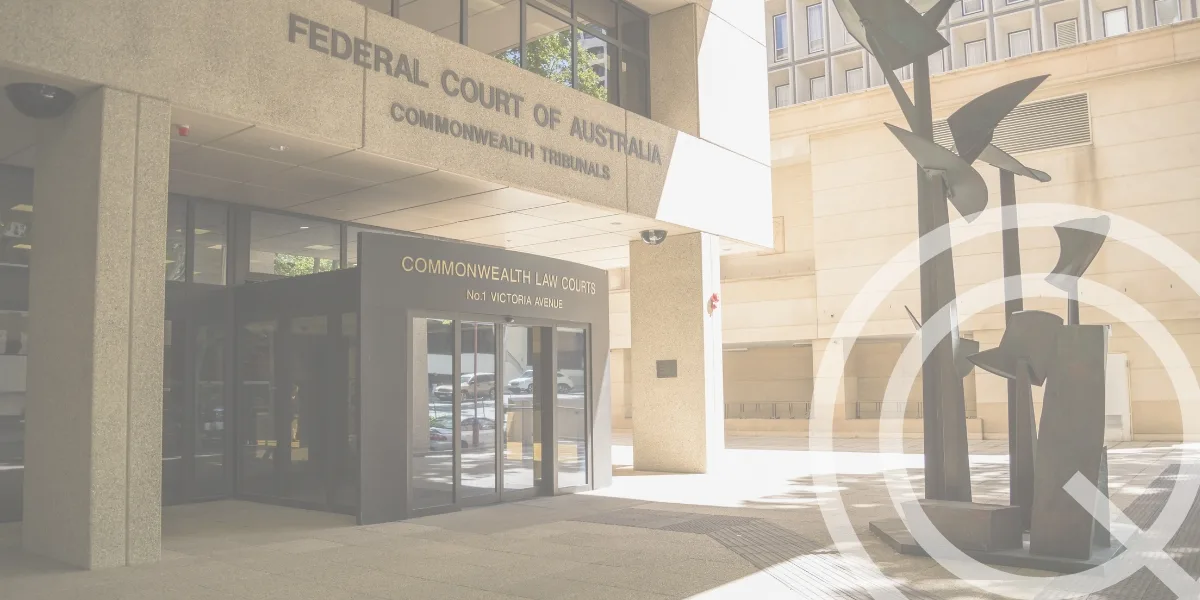Lehrmann v Network Ten Pty Limited (Trial Judgment) [2024] FCA 369
The Lehrmann judgment provides a rare masterclass in how to apply the civil standard of proof to allegations involving potential criminal conduct.
KEY TAKEAWAYS:
- Assessing credit in cases of sexual assault requires careful consideration of trauma and its well-established impacts on memory.
- Witness evidence is inherently unreliable making contemporaneous documentary evidence highly valuable.
- Even when applying a trauma-informed approach, investigations into sexual misconduct should be approached with an open mind and without prejudgment – a respondent is entitled to be presumed innocent until proven otherwise.
- When making a finding on the balance of probabilities, reasonable satisfaction that something has occurred cannot be attained without taking into account the nature and seriousness of the alleged act, the gravity of the consequences and the inherent unlikelihood of the event happening.
- Rejecting one part of a person’s evidence should not automatically render the entirety of their evidence untrue.
- You don’t have to accept either party’s account, but that is not a reason for an investigator to ‘fence-sit’; rather if they are not satisfied on the balance of probabilities that something occurred, the allegation is not substantiated.
- Avoid making unnecessary criticisms or credit findings of a witness, especially based on observations of demeanour.
The judgment handed down by Federal Court Judge the Hon Justice Lee in the high-profile defamation case of Lehrmann v Network Ten Pty Limited is a masterclass for workplace investigators on credibility findings and how to apply the civil standard of proof to potentially criminal conduct.
The case deals with the unique combination of a civil defamation action about a Network Ten episode of The Project said to have implied that Mr Lehrmann raped a female parliamentary staffer in 2019, met with the defence of substantial truth led by Network Ten. This presented the court with the unenviable task of determining, on the balance of probabilities, whether the rape took place.
In workplace investigations, findings are made on the civil standard of proof – the balance of probabilities – even where the alleged conduct is potentially criminal. This means that to substantiate an allegation, the evidence must show it is more probable than not that the alleged conduct occurred.
The Lehrmann judgment provides a rare masterclass for workplace investigators on how to apply the civil standard of proof to allegations involving potential criminal conduct – in this case, an allegation of rape. In such cases, credibility findings are often critical and the judgment provides a useful reminder of factors to consider in making those all-important credibility calls.
Here are just some of the pearls of wisdom from the judgment.
Lesson 1 – Witness evidence is inherently unreliable
One of the headlines from the judgment is that human memories are fallible, that people give unreliable evidence for various reasons and that distinguishing between a false memory and a lie can be difficult.
Rare is the workplace investigator who has not learned this lesson time and time again, but it is reassuring to have the court endorse the sentiment.
In this case, the court found both key parties to be unsatisfactory witnesses, but for varied reasons and highlighted the importance and value of documentary evidence (where available) over witness accounts. This will again be a familiar refrain for investigators who well understand the significance of a contemporaneous document in a case involving competing accounts.
Lesson 2 – The balance of probabilities is more than a simple estimate of probabilities
More than simply balancing the likelihood of something happening, the court emphasised that a finding on the balance of probabilities ‘requires a subjective belief in a state of facts’ on the part of the fact-finder. Citing the well-known case of Briginshaw v Briginshaw, the court put this another way: the fact-finder needs to feel ‘an actual persuasion’ of the occurrence of the fact, which makes the seriousness of the allegation relevant.
Reasonable satisfaction that something has occurred cannot be attained without taking into account the nature and seriousness of the alleged act, the gravity of the consequences and the inherent unlikelihood of the thing happening.
Lesson 3 – A presumption of innocence exists even in cases of alleged sexual misconduct
With the growth in understanding of the importance of trauma-informed approaches, there have been pockets of misunderstanding about the presumption of innocence. The importance of believing a victim in appropriate (support-related) contexts does not usurp the investigator’s fundamental obligation to remain impartial and to hear both sides with an open mind.
Echoing this caution, the court (again citing Briginshaw) refers to the gravity of the rape allegation and the need for weight to be ‘given to the presumption of innocence and exactness of proof expected’.
Acknowledging the broad spectrum of ‘visceral’ responses to allegations such as those tested in this case, Justice Lee referred to some people being ‘sceptical about complaints of sexual assault’ and who ‘hold stereotyped beliefs about the expected behaviour of rape victims, described by social scientists as “rape myths”.
He also referred to others who ‘say they “believe all women”, surrendering their critical faculties by embracing and acting upon a slogan arising out of the #MeToo movement’.
This was a clear reminder of the importance of coming with an open mind and without prejudgment or preconceptions about actions or motivations.
Lesson 4 – Assessing credit in cases of sexual assault
The judgment is illuminating on the topic of assessing the credit of a complainant in a sexual assault case, citing academic articles on ‘rape myths’ and misconceptions in a judicial context. In an encouraging sign that some of these myths may soon be banished to the past (judicially-speaking), some key facts were agreed between the parties in this context, including:
- That trauma can have a severe impact on memory by splintering and fragmenting memories and interfering with the timespan memories require to consolidate and become permanent.
- Consequently, memory can change – meaning that changes in a complainant’s story may not indicate a lack of credit. Inconsistent reports following trauma are not uncommon and can be explained by theories of trauma and memory function. Put simply, the science tells us that inconsistencies in a person’s story do not prove that the person is lying.
- Many factors may impact a complainant’s account, including how it was elicited (and whether by someone with appropriate skill), the time elapsed (relevant to memory consolidation) and the emotional or psychological state of the person at the time of interview.
Lesson 5 – One false statement does not a liar make
The judgment reminds us that the rejection of one part of a person’s evidence does not require the fact-finder to reject the whole of their evidence.
Justice Lee expertly navigates this principle by accepting aspects of the parties’ evidence while rejecting other parts.
The judgment also reminds us to be careful not to characterise every incorrect statement as a ‘lie’. To describe someone as having lied is a serious accusation, and often an equally possible explanation is that the person misremembered rather than intentionally sought to deceive (see Lesson 1).
Of course, it remains open to the fact-finder to determine that a person’s account is so full of error or deception as to render their evidence wholly unreliable (as was ultimately the court’s conclusion in relation to Mr Lehrmann).
Lesson 6 – You don’t have to accept either party’s account
Allegations of sexual misconduct rarely involve witnesses for obvious reasons. Yet the judgment makes clear that this does not force the fact-finder to prefer one account over the other.
In the words of Justice Lee: ‘In general, disbelief of one witness’s account does not establish the contrary, or that a witness giving a contrary account must be believed’.
Equally helpful is his Honour’s next statement that, if unable to find what actually happened, ‘it is open to decide the issue on the basis that the party who bears the onus of proof on this issue has failed to discharge their burden’.
The message here for workplace investigators is that if you cannot establish what occurred, it is not necessary (or advisable) to fence-sit; to the contrary, the objective is to determine whether the evidence supports that something happened to the relevant standard of proof. If the investigator is not satisfied on the balance of probabilities that something occurred, the allegation is not substantiated. The conclusion of ‘unable to make a finding’ is unhelpful to a decision-maker and should be relegated to the (hopefully) rare circumstance where key evidence is missing or simply unavailable.
Lesson 7 – Go easy on the credit findings
Another solid tip for workplace investigators is the court’s caution against making unnecessary criticisms or credit findings of a witness, especially based on observations of demeanour. If it is not directly relevant to a finding, then the age-old wisdom remains sound – if you don’t have anything nice to say, don’t say anything at all.
No fence-sitters here
It’s not every day that a superior court of record in Australia gifts us with a masterclass in applying the civil standard of proof.
Perhaps one of the greatest lessons the judgment gives investigators is not to sit on the fence. Despite painstakingly navigating the conflicting evidence and legal questions in this case, Justice Lee leaves nobody wondering.
For investigators with a tendency to be overly diplomatic at the expense of clarity, one might consider Justice Lee’s conclusions on the credibility of Mr Lehrmann as a lesson in plainness:
“I do not think Mr Lehrmann is a compulsive liar, and some of the untruths he told during his evidence may sometimes have been due to carelessness and confusion, but I am satisfied that in important respects he told deliberate lies. I would not accept anything he said except where it amounted to an admission, accorded with the inherent probabilities, or was corroborated by a contemporaneous document or a witness whose evidence I accept.”
More information
Seasoned workplace investigators from Q Workplace Solutions – one of Australia’s largest independent specialist workplace investigations firms – will detail how to apply trauma-informed principles to workplace investigations (from taking the initial complaint, to interviewing and communicating with participants at the conclusion of the investigation) at an upcoming Q Workplace Training online workshop on 22 July. Places are limited.
Q Workplace Solutions’ team of experienced and legally qualified investigators are trusted by public and private organisations, including ASX-listed companies and government departments, to investigate complex and often highly sensitive allegations of employee wrongdoing. They also undertake culture reviews of organisations, divisions or teams; review workplace investigations and investigation processes; and provide training, coaching and advisory support to internal investigation teams.






